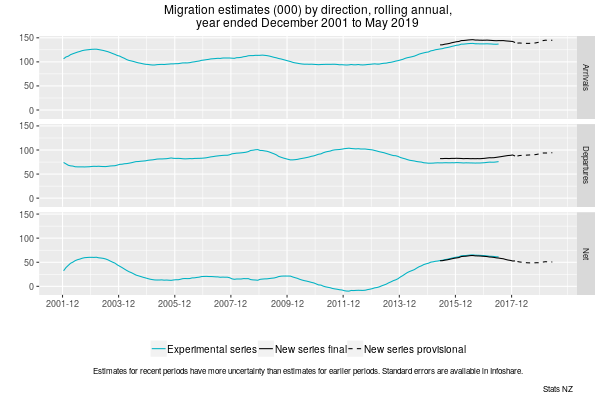Annual net migration was provisionally estimated at 50,200 (± 800) in the year ended December 2018 compared with 52,600 in the previous year, Stats NZ said today.
"Net migration has remained high since 2014, with a peak in 2016," population indicators manager Tehseen Islam said.
"Over the past four calendar years, 224,000 more people came to New Zealand than departed. That's equivalent to the population of Wellington city, or about 150 more people every day.

More than half the net gain in migration came from Asia, especially India and China, with provisional net gains of 47,800 and 38,600 respectively over four years. In the same four-year period there was a net gain of 11,200 migrants from the United Kingdom.
"New Zealand is seeing a sustained period of high net migration relative to its population," Mr Islam said.
"This has helped boost the total population, which has grown by an average of 2 percent per year for the past four years. People are both arriving and leaving in large numbers each year, which reflects large numbers of migrants arriving on work and student visas."
Every year, more New Zealand citizens leave the country than arrive back as migrants. However, the net outflow over the past four years (22,600) was much lower than the previous four years 2011-14 (97,500).
In 2018 alone, 142,900 (± 700) migrants arrived, including 34,700 (± 300) New Zealand citizens, while 92,800 (± 600) left after living here for more than a year, making a net annual gain of 50,200 (± 800) migrants.
Text alternative for diagram, Estimated migration (mean estimate), year ended December 2018.
Why are we talking about migration in the 2018 calendar year?
Annual arrival and departure data are subject to notably less revision at 5-6 months after the reference period. By this time there is more certainty about whether travellers are short-term or long-term (migrants), according to the 12/16-month rule.
"We are confident the new 'outcomes-based' measure of migration is more accurate than the previous 'intentions-based' measure. That's because it's based on what people actually do when they cross New Zealand's border, rather than what they say they will do," Mr Islam said.
Year ended May 2019 - provisional migration estimates
Some users of migration data may still want to look at the most recent provisional data.
Provisional estimates for the year ended May 2019:
- migrant arrivals - 144,900 (± 1,400)
- migrant departures - 94,400 (± 1,200)
- net migration gain - 50,500 (± 1,400).
More migration estimates to be published soon
A subnational breakdown of migrant arrivals, migrant departures, and net migration will be available in next month's release (on 9 August). Final estimates for subnational areas for the years ending June 2014 to February 2018 will be available.
Text alternative for graph, Migration estimates (000) by direction, rolling annual, year ended December 2001 to May 2019
Three time-series line graphs show outcomes-based estimates for migrant arrivals, migrant departures, and net migration, from rolling annual years ended December 2001 to May 2019 - for experimental series and new series. The graphs show final estimates from May 2015 to January 2018, and provisional estimates from February 2018 to May 2019, for the new series of migration. An experimental series for December 2001 to June 2017 gives a longer time series.
Text alternative for diagram, Estimated migration (mean estimate), year ended December 2018
Diagram shows estimates for migrant arrivals, migrant departures, and net migration, for the year ended December 2018. Arrivals of non-New Zealand citizens were 108,300 (± 600) and departures were 47,900 (± 400), making a net migration gain of 60,300 (± 600) non-New Zealand citizens. Arrivals of New Zealand citizens were 34,700 (± 300) and departures were 44,800 (± 400), making a net migration loss of 10,100 (± 500) New Zealand citizens. Result is a total net migration gain of 50,200 (± 800). Note: The provisional estimates have 95 percent confidence intervals (±) alongside them - the wider the interval, the greater the uncertainty about the estimate. However, these intervals reflect the model uncertainty, not the extent of future revisions to provisional data.






